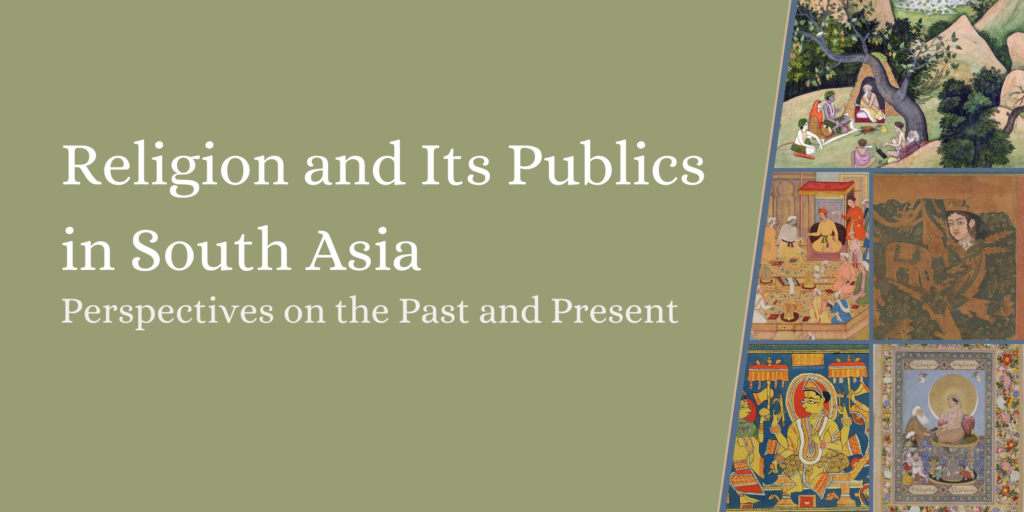
Image adapted from The Fabulous Creature Buraq by unknown author and a painting by Nar Singh (Public Domain)
A virtual conference sponsored by Canopy Forum and the Center for the Study of Law and Religion at Emory (CSLR) featuring scholars, experts and practitioners who will examine the many religious traditions of South Asia and their diverse publics. Participation by invitation only. View selected videos and browse all essays here.
‘Not a religion:’ Modern Hinduism and the Emergence of Hindutva

Supriya Gandhi
A furor is raging in the Indian state of Karnataka. Do Muslim students and faculty in schools and colleges have a right to wear the hijab on campus? This debate has stoked a societal conflict that has been swiftly growing ever since the Hindu nationalist government of Narendra Modi was elected in 2014. A number of questions have surfaced for debate both in the Karnataka High Court, as well as in the media. Can religious clothing be permitted in a secular educational setting? Is the hijab an “intrinsic” part of religious practice for Muslim women? In a public sphere dominated by Hindu nationalists, there is little sympathy for the rights and agency of these students. For now, the High Court has temporarily banned the use of “religious clothing” in colleges with uniforms. Visuals of students and teachers being forced to remove articles of clothing at the gates of their institutions serve as a spectacle for voyeurs celebrating their humiliation. These incidents build on decades of right-wing moves to both sexualize and racialize Muslim bodies.
Amid this manufactured controversy, the hijab and the burqa emerge as symbols of religion. By contrast, in this case, the panoply of Hindu sartorial and bodily markers—such as the tilak, bindi, and vibhuti worn on the forehead, as well as ritual threads tied around the wrist or slung across the torso of male Brahmins—are not seen to carry the same religious connotation. Indeed, a clip filmed during this controversy depicts a Muslim girl being turned away from school by a teacher whose forehead bears exactly such a religious symbol. The idea of secularism selectively applied here is more akin to the French laïcité than to the longstanding Indian idea of secularism as embracing religious pluralism. Moreover, while one could well make the argument that Indian secularism had never been fully divested from Hinduism, this right-wing conception posits no boundary between Hinduism and secularism. This view holds that the two are melded together because Hinduism is not really a religion but the manifestation of India’s “civilizational” ethos.
Is Hinduism a religion? According to several judgments of India’s Supreme Court it is not.
A famous instance pertains to the case of Yeshwant Prabhoo v. Prabhakar Kashinath Kunte in 1995. Here, the politician Yeshwant Prabhoo was charged with using “corrupt practices” during an election, by soliciting votes on religious grounds. The court’s judgment, authored by Chief Justice J.S. Verma, contained a discussion of the terms “Hinduism” and “Hindutva” that would have far-reaching repercussions. The judgment states, “…these terms are indicative more of a way of life of the Indian people and are not confined merely to describe persons practicing the Hindu religion as a faith.” It adds, “Ordinarily, Hindutva is understood as a way of life or a state of mind and it is not to be equated with or understood as religious Hindu fundamentalism.”
The judgment takes Hinduism and Hindutva to be equivalent terms. Here Hindutva is understood in its literal sense as ‘Hindu-ness,’ rather than the form of Hindu supremacism espoused by Vinayak Savarkar, the foundational ideologue of this concept. In the court’s assessment, talking of Hinduism or even Hindutva could not in itself constitute an appeal to religion. Chief Justice Verma, who also stood up for minority rights during his career, was careful to warn against the “misuse of these expressions to promote communalism.” However, his equation of Hinduism with Hindutva in this judgment received the approbation of the Hindu nationalist Bharatiya Janata Party, though it also incurred criticism from secular intellectuals.
This Supreme Court judgment merely voiced, and perhaps helped solidify, a widespread view. Over the course of the twentieth century, the declaration “Hinduism is not a religion” had gained the status of a truism. Today it is also commonly uttered on social media. This statement is often found together with the related claim that Hinduism is, instead, “a way of life.” Several eminent figures with diverse ideological commitments have invoked such an idea, including India’s first prime minister Jawaharlal Nehru, the philosopher-statesman Sarvepalli Radhakrishnan, and the writer Nirad C. Chaudhuri.
The notion that Hinduism is not a religion, but instead a universal (and thus seemingly caste-transcending) and nebulous way of life, was crucial to the historical development of Hindutva ideology, even though many of its proponents include those who were far removed from, or even reviled, Hindutva. The proposition that Hinduism or Hindu-ness signifies an amorphous way of life does not merely describe the fact that the tradition has no specific founder or central sacred text. It can have implications that are normative as well. If Hinduism is a way of life that cannot be bottled up in a container labeled ‘religion,’ then it flows like water from a source unlocatable in space or time; its rivulets form the subcontinent’s lifeblood.
Hinduism, thus positioned, becomes the underlying substratum of all religions in South Asia. This view, by implication, privileges Hinduism over the “Abrahamic religions,” which are not seen to have the same universalistic breadth. One late-twentieth-century formulation of this approach renders explicit its implicit assumptions: “In India, Hinduism is called Sanatana Dharma, which means literally ‘the eternal religion.’ There are two reasons why it is so called. First, unlike other religions, it has no propounder, and consequently its beginnings cannot be traced to a specific date in antiquity. Second, with all its subdivisions, it can be said to incorporate the spirit of the world’s diverse religions, and thus can be equated with the eternal Religion itself.”
Like many other universal claims, this one too can be historicized. The notion that Hinduism was not just a ‘religion’ but ‘Religion,’ achieved expression in the nineteenth century—precisely as Hinduism, under the colonial gaze, crystallized as a world religion among a pantheon of other faiths. Elite Hindus put forth diverse and often competing conceptions of a religion that was at once universal and also Hindu. There emerged various ways of fashioning Hinduism as the anti-religion—one that outshone other religions by virtue of its universality and eternality. By contrast, the narrower and more contingent sphere of ‘religion’ came to be reserved for Islam and rival Hindu groups. Those who embraced different versions of a universal Hinduism included members of the Brahmo Samaj as well as the Arya Samaj and the Sanatan Dharm Sabhas—all of which were prominent Hindu associations in colonial North India.
While modern Hindu reform movements may well have been forged in the colonial crucible, they also built upon a number of precolonial traditions including the monistic school of thought known as Vedanta. Among the diverse intellectual strands shaping modern Hinduism is one that today may seem surprising or unexpected––the domain of Persian and Urdu letters. Indeed, as my ongoing research shows, many debates on Hinduism in the nineteenth century took place in Persian or Urdu—languages that eventually came to be associated primarily with Muslims—owing to the Persianate culture fostered earlier by the Mughal state and later by colonial rulers. Writers such as Rammohun Roy (d. 1833), Sadasukh ‘Dihlavi’ (fl. 1850s), Kanhaiyalal Alakhdhari (d. 1882), and Shraddha Ram Phillauri (d. 1881), repurposed earlier Persianate ideas of a universal truth for their reformist or revivalist projects targeting Hindus. Each in his own way advocated a universal Hinduism (though they did not all use this very term) that was widely encompassing and also shorn of beliefs and practices deemed corrupt or unessential. It is noteworthy, however, that even the most sectarian-minded of these writers did not advocate anything close to the type of Hindu supremacism seen today.
Still, the complex recent history of the idea that Hinduism (by any name) is an all-pervading, eternal source of universal wisdom, is relevant to our understanding of religion and secularism in South Asia today. The universalizing and secularizing moves by Hindu intellectuals in the nineteenth century helped frame the modern discourse of Hinduism as not a religion, but as a way of life. If we start out with a notion of Hinduism as the eternal dharma, then we only need to take a short conceptual step to the idea of Hindu-ness, unrestricted by the particularities of caste, sect, or region, as the cultural or civilizational matrix buttressing the whole of India.
Indeed, the ideology of exclusionary Hindu nationalism, which Vinayak Savarkar famously expounded in 1923 as “Hindutva,” built upon the diffuse, universal Hinduism popularized in colonial India. For Savarkar, the test of Hindutva or Hindu-ness did not involve adherence to any specific kind of religious belief or practice. He considered even Sikhs, Jains, and Buddhists to be Hindus. Rather, this test entailed the act of acknowledging India to be the fatherland as well as the holy land. Muslims and Christians, for Savarkar, did not fulfil both these conditions. Savarkar distinguished between Hindutva, the racial and civilizational ideology described above, and Hinduism, which he associated with religion. For him, the lines between Shaivas and Jains, or between Buddhists and Sikhs, were blurred. The line separating Hindus from Muslims was sharp and clear.
Modern Hindu nationalists may not all follow Savarkar’s ideas to the letter. But, like him, they delimit the boundaries of an expansive, “thin” Hinduism with the unyielding, indelible line of communalism. The resulting consequences are what we see playing out in Karnataka today. Savarkar would have hoped for this—the creation of a majoritarian state-society in which minorities are relentlessly singled out for subjugation and domination. ♦
Supriya Gandhi teaches at Yale University and works on the interface of Islam and Indic traditions in South Asia. She is the author of The Emperor Who Never Was: Dara Shukoh in Mughal India (Harvard University Press, 2020). Her current book project explores the role of the Persianate cultural and intellectual ecumene in the making of modern Hinduism.
Recommended Citation
Gandhi, Supriya. “’Not a religion:’ Modern Hinduism and the Emergence of Hindutva.” Canopy Forum, March 7, 2022. https://canopyforum.org/2022/03/07/not-a-religion-modern-hinduism-and-the-emergence-of-hindutva/.

